How to Create
Transparency in the Workplace (and Boost Your Team’s Productivity)
Besides hitting your company’s revenue goals, what’s another critical area you must succeed in as a manager?
It’s building and sustaining a more engaged team.
And that’s because engaged teams aren’t only more productive. They yield a whopping 21% increase in profitability, according to Gallup.
On the flip side, with poor engagement among team members comes lower employee retention and turnover.
And those aren't even the worst.
There's the crippling sense of self-doubt that'd haunt and frustrate your role as manager. Ultimately, it’d interfere with your ability to lead your team well enough to hit company targets.
Imagine the chaos that’d follow, particularly the damage to your reputation (as well as your company's).
All these bring us to a question every great manager must constantly ask: How do I boost my team’s productivity and better lead them?
Well, you’ll achieve this if you...
Build workplace transparency.
A transparent workplace is one where 1) open communication thrives, 2) the people align, 3) trust builds, and 4) loyalty is sure.
In other words, your team has a clear understanding of the company’s direction. They know how their day-to-day tasks help to achieve set goals. They give honest, direct feedback, knowing you’ll take action. These insights, in turn, help you focus your efforts.
And what are the results of focusing such efforts, you ask?
A continuous increase in engagement, productivity, retention, and of course, profits.
So, how do you build a transparent culture that values openness?
You need two ingredients.
First is strategy. You’d need an action plan to direct your efforts, get results, and track progress.
Unfortunately, if you don’t know what employees think about you (and the company), you’ll struggle to create an effective company-wide transparency strategy.
Now that’s where tech, the second ingredient, comes in.
Specifically, a team pulse survey software.
It’s a system designed to help you know if transparency is a priority in your organization with insights on what to do (if it isn’t).
In this guide, I’ll show you how to blend strategy and technology to build a transparent culture that boosts productivity.
Table of Contents:
Do you have a transparent workplace culture?
Build a culture of transparency to improve employee engagement with ShowUp.io
What is Workplace Transparency, And Why is It Important?
Workplace Transparency thrives on open, sincere communication.
It's like a two-way street.
On one end of the street are employees. And there is you, the manager (and company management), on the other end.
To achieve company goals, both parties have to move in the same direction (towards achieving company goals)
But this can only happen where there is ongoing open, honest communication that starts with you!
When you share information openly with your team, you give them a reason to trust you. And they'll feel like a valuable part of the team.
Also, when you listen for their feedback, you understand what they think about you (and the company).
Ultimately, you end up with actionable insights for your next steps.
Take this route, and not only will your people trust your leadership more. But, they’ll be more inclined to give their best to drive company growth.
No wonder Kristen Gillibrand said:
When you open the door toward openness and transparency, a lot of people will follow you through.
Now, following Kristen’s words, how do you open the door to transparency by building a strategy for it in your organization?
As I mentioned earlier, it starts by getting factual ideas of your team’s pulse. And how do you achieve that?
It’s simple.
Gather honest feedback directly from team members.
And that’s where ShowUp, a team pulse survey tool, comes in.
How Team Pulse Survey Can Help Create a Transparent Company Culture
As the name goes, the goal of performing a team pulse survey is to track your team's pulse on an ongoing basis.
And the purpose of this is to get real insights revealing your team's sincere thoughts and sentiments.
These insights, in turn, inform your strategy and help focus your efforts on areas your attention is most needed.
With a comprehensive team pulse survey like ShowUp, you can track five essential transparency traits:
- Accountability
- Collaboration
- Sincerity
- Cooperation
- Consideration
Each of these traits plays a unique role in creating transparency in the workplace. Together, if each is maximized, your team will operate as effectively and efficiently as possible.
Accountability, for instance, keeps managers and employees in check.
It simply means taking responsibility for one’s attitudes, actions, performance, and choices.
When a team is accountable, they perform better.
The flow of information is more effortless, expectations are well-defined, and they learn from mistakes.
Most managers, however, struggle to keep their teams accountable.
And don’t take my word for it.
A 2019 CEO Benchmarking Report found that holding people accountable was the single biggest challenge leaders face:
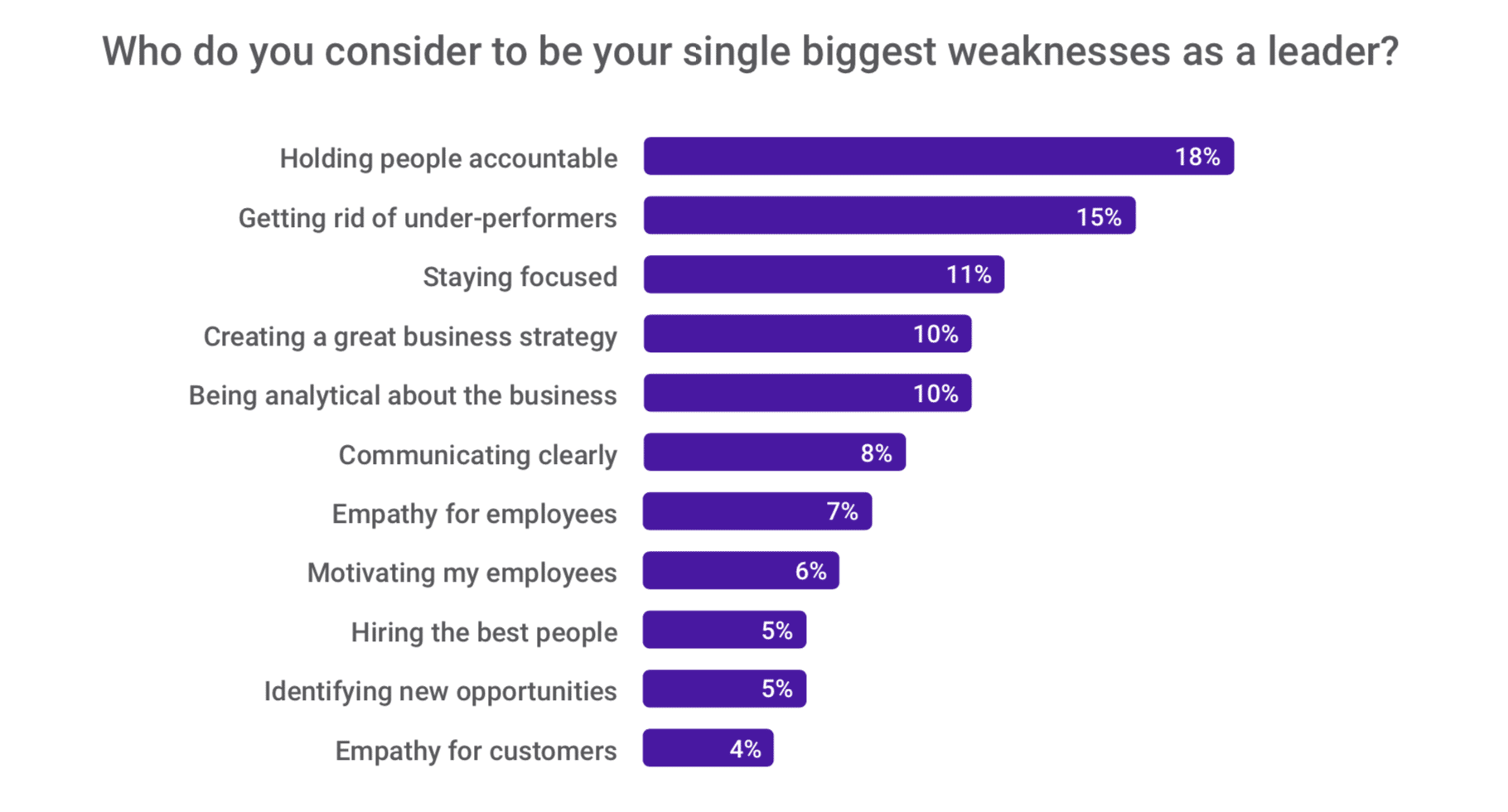
[Source]
As a manager, take this seriously because, without accountability, your team will lose motivation.
They'd prioritize other activities over your company's. And if you leave it unchecked, it could degenerate into something far worse.
Pushing past that weakness and holding your team accountable, as a manager, gives them a reason to trust and respect you.
The result?
Increased productivity, increased engagement, and loyalty. And, of course, a healthy self-esteem boost.
Again, don’t take my word for it.
Alan Mulally, former president and CEO of Ford Motor Company, said:
When people feel accountable and included, it is more fun.
ShowUp measures accountability (and other traits) in a super-easy way.
You can know what employees think about you and your company in seconds, not days or weeks.
And it's pretty straightforward to do.
After you sign up, you can invite your team members, and they'll receive surveys directly in their inbox (weekly or biweekly, depending on which you choose).
Say you choose to check your team’s pulse weekly.
In such a case, every week, your team will get an email that looks like this:
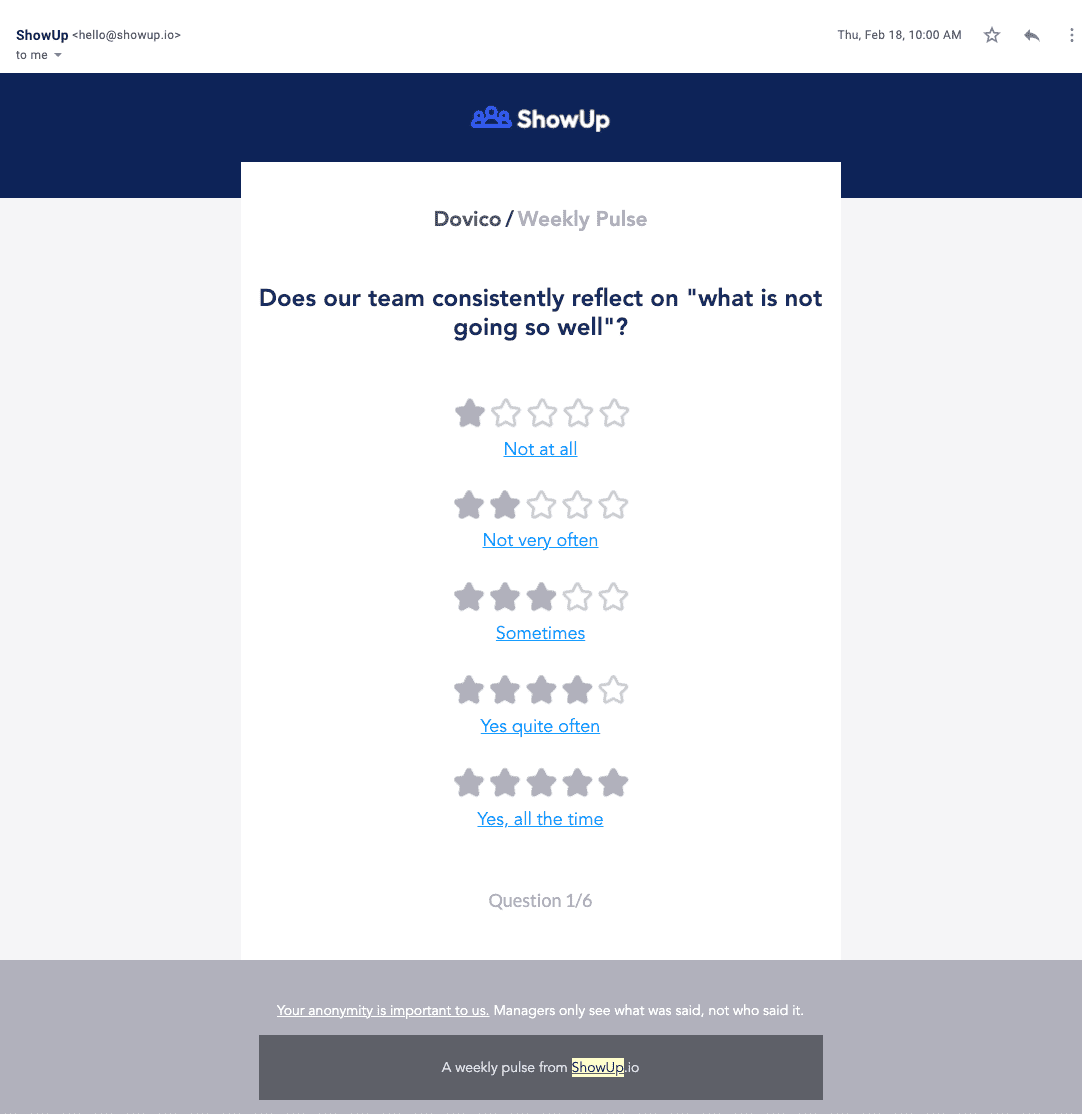
To participate in the survey, all an employee needs to do is click on one of the options provided in the email.
For example, “Yes, quite often.”
And once they do, ShowUp smoothly transitions them to complete the survey easily:
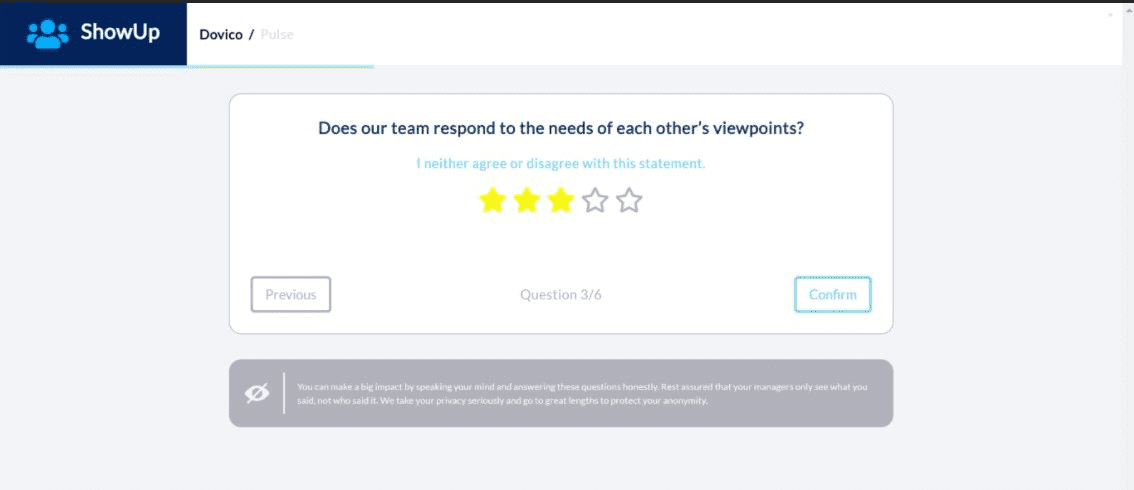
In all, they’d answer six questions, and you get a measure of relevant individual traits. And the goal is to help you pinpoint where problems are so that you can focus your efforts.
With these insights, you can uncover transparency gaps and fix areas where trust has been broken.
The survey, of course, is anonymous.
Offering employees anonymity helps them openly answer questions sincerely. So, you can get more accurate results.
That way, your focus is on using employees' responses to improve your company culture (rather than focus on who said what).
Here’s what the result can look like:
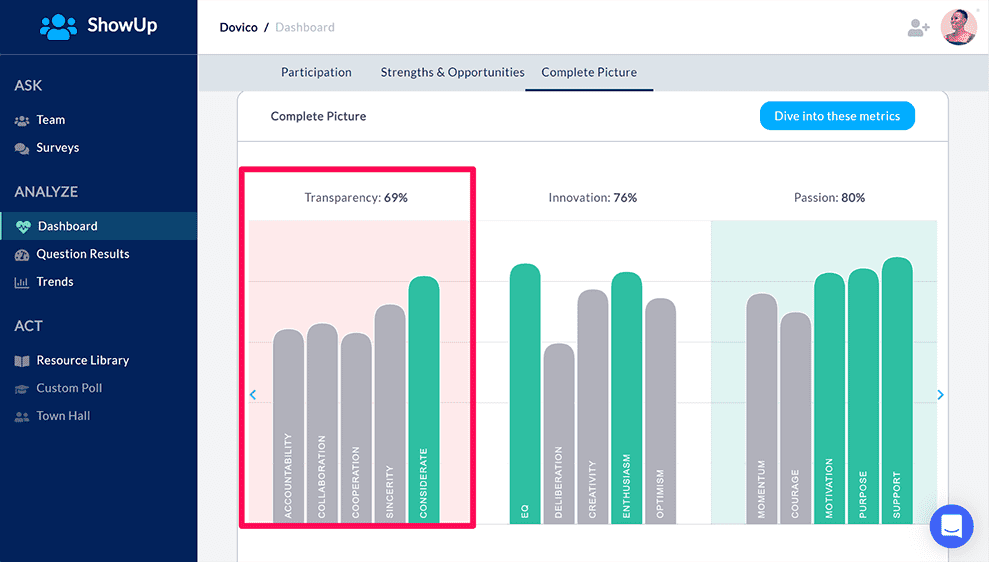
You can see from the results that among the six traits ShowUp measures, the transparency score is the lowest (below 70%).
If this were your team, you’d see right off the bat that there’s an issue on that front. It also means you know exactly where to focus your efforts first.
And with such straight-from-the-horse's-mouth insights at the tip of your fingers, you can take immediate action and avoid a disaster.
Of course, you can also take a deep dive into the transparency metric and pinpoint exact problem areas.
Take the screenshot below, for instance:
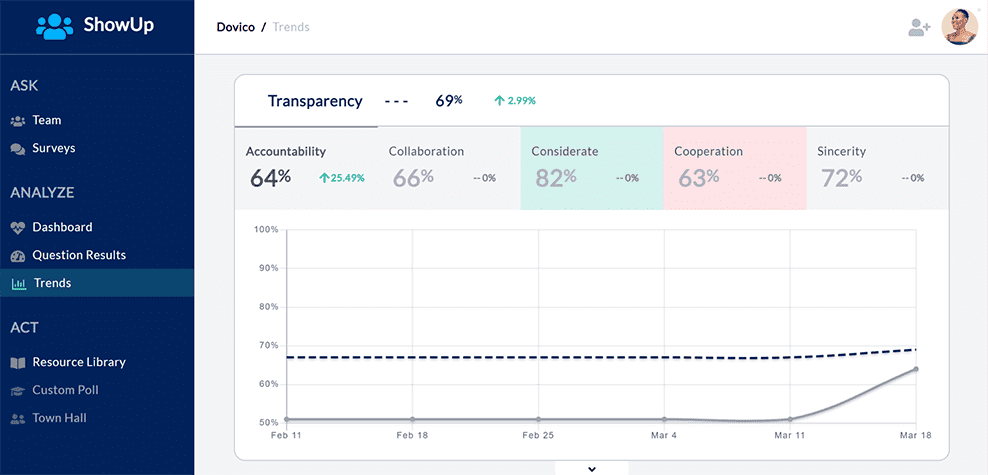
Taking a deep dive, you can see that the lowest score here is cooperation (63%). That's where you should focus your attention.
The ShowUp platform doesn’t just stop at giving you insights.
You also get a backlog of resources to immediately start creating an action plan to solve this problem:
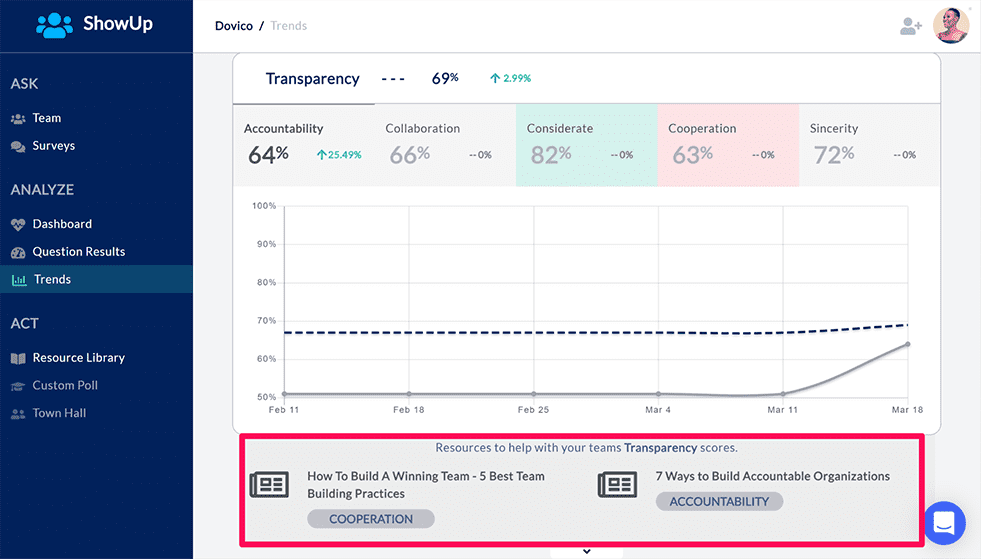
So, there you have it...
I’ve just walked you through how technology, a team survey tool, to be specific, can help you create a transparent company culture.
If you equip yourself with a team pulse survey platform like ShowUp (and follow the steps above), you’ll be up and running in no time.
Do your employees have the environment they need to thrive?
Is your company transparent? Is everyone aligned? Is mutual respect fostered? Can they be innovative? Is leadership trusted? Are they passionate about their work? Are you aware of your "unwritten rules"?
Not sure? Then it's time to start listening. Ignoring your culture can negatively affect your turnover rate, growth, and your bottom line.
Now beyond using technology, what other strategies can you use to create a transparent culture?
Let’s go over six of them.
6 Ways to Create Transparency in the Workplace
1. Be Honest
The best teams run on sincerity.
When you share vital information, your team becomes more accountable, collaborative, innovative, and happier.
They become more aligned, understanding your company's vision and purpose. This, in turn, boosts engagement.
On the other hand, withholding information creates friction on your team. It robs your team of trust, happiness, productivity, and innovation.
Take Buffer, for instance.
Joel Gascoigne, CEO of Buffer, shared their salaries and salary formula in 2013.
They wanted to kill petty office politics that thrived as a result of salary secrecy. So they made everyone's pay public. Of course, the team discussed and agreed with the idea before it was published.
The result?
The team’s trust level dramatically increased, boosting retention rates.
It even helped their recruitment efforts. Job applications increased 230% in the next month!
See how much their efforts paid off?
You don't have to do it as Buffer did.
Find what works for your company and do it.
You can get started by holding weekly stand-ups and roundups.
Here, everyone on the team gets to share and learn about projects and relevant company updates.
- internal information or
- tracking down colleagues who can help with specific tasks.
2. Share the Ups and Downs with your Team
It's great to share wins with the team. But don't stop there.
Share your losses as well.
When you let employees know the losses and challenges you face, they feel a sense of belonging and responsibility. And they become united, more productive, and happier.
Be open to admitting when things aren't going as planned.
This kind of open communication builds trust and confidence in your leadership as well as the company.
Employees are adults, not babies.
They can sense when things go wrong, and they can handle the good and the bad.
When you hold back information, you are leaving room for assumption. And they might imagine things to be worse than the truth.
This can spread fear among your team if they share their assumptions.
Bottom line?
Keep them in the loop.
Don’t try to sugarcoat the negatives. Instead, be sincere about failures. Give your team a chance to learn from the failures and brainstorm the way forward together.
That’s how sustainable growth happens.
3. Know Where to Draw the Line
Being transparent doesn't mean you should share everything with everyone.
It is rather about ensuring that your team has the information they need to work effectively.
To avoid too much transparency, set clear policies and manage expectations, especially for salary information.
Tim Low, vice president of PayScale, said:
Salary is an emotional topic for most people. It can cause chaos if it’s suddenly thrown into the light without clear policies around it.
If there’s a need to share salary information, you can openly share how management reached the salary decision rather than focus on the actual figures.
Also, If you want to share your company's financials, you can give an overview. The overview lets employees know how the business is doing.
You can withhold sensitive details, especially details that can compromise the company.
Bottom line?
Find your comfort level as a company and stick with it. Figure out what information you'd like to share and do that.
4. Hire People Who Value Transparency
Attracting and hiring great talent takes honesty.
Job seekers, in this century, demand transparency now more than ever.
A Glassdoor survey found that the number one grievance job seekers have is the lack of information about benefits and compensation.
When you withhold information from potential hires, you risk losing high-quality leads.
Here's the sweet spot:
87% of people want to work for companies that value transparency.
The best way to attract and hire these people?
Be open about sharing information that'd help potential hires see you as sincere.
Introduce openness into your hiring process.
For instance, while emphasizing the best parts, you can honestly share the job’s day-to-day activities.
You can do this while posting the job and during the interview. And don't try to shove in any extra responsibilities after you've hired them.
Consider including what employees love about your company from insights gathered via your weekly pulse surveys.
You should also be transparent about salary and compensation. This is a huge motivator for new hires, so milk it.
Also, share your company's values early in the interview process, and check to see how candidates respond.
Of course, potential hires might say what you want to hear just to get through the interview process.
To avoid this, here's what you can do:
Take a pulse survey the first week they join the team.
Test to see if they truly understand your company's vision, values, their responsibilities, and other equally important details.
It's never too early to start tracking using a survey tool. That way, you'll have real, accurate data as proof that they share your values.
5. Give Your Team Access to Information and Trust Them to Make Decisions
When a team is aligned, everyone understands the company's vision and their part in the story.
And they can make better-informed decisions.
Communicate what the priorities are for each project so that everyone can work together toward a common goal.
You should also ensure that critical information (such as ongoing projects) is easily accessible and readily available.
You can use project management tools like Trello (and shared calendar like Google Calendar).
Also, do more than share content. Give context as well.
It's like Des Traynor, Co-founder of Intercom, said to Know Your Team:
The key thing people forget in transparency is it’s not about opening up Google Drive and making sure that everyone can read everything. It’s about the transparency of context as well.
When sharing a file, for instance, the file name should help your team understand its purpose. And you can share relevant, additional information that will make their experience smoother.
6. Choose Tools that help you build a transparent culture
The average employee, according to HubSpot, spends 20% of their workweek looking for:
And that’s an inefficient use of work hours in action!
There are a variety of digital tools that can help your teamwork without hassles.
Tools like Trello and Ora make it easy for everyone to track and collaborate on multiple projects simultaneously.
Google Drive also allows employees to organize, store, and find information quickly. Slack breaks communication barriers. You can share all kinds of messages, including announcements with employees.
Conclusion: Create a Positive, Transparent Company Culture
The bottom line is this:
If you want a transparent culture, then you need to get real with your employees.
You'll have to embrace the risk of vulnerability for the greater good.
There are, after all, no rewards without risks.
When you show vulnerability, you create an open company culture where employees can share their opinions.
As you share information with your employees, trust grows, and employees are a lot happier, more engaged, and ultimately productive.
They also have a better understanding of the company's "why.”
That way, they feel like they are a part of something bigger than making profits.
ShowUp measures your team pulse and boosts employee engagement.
You can use the feedback from the survey to measure your performance and focus your efforts.
When you take action on feedback, you give your employees good reasons to trust your decisions and give their best.
